Atlantic Monthly Contributors's Blog, page 320
October 17, 2015
Slovenia: The New, Tiny Pathway to Western Europe

Hungary, as promised and despite objections, sealed its border with Croatia at midnight on Saturday, diverting the stream of refugees heading through the country.
Much can and has been said about Hungary and its policies toward migrants, its inflammatory rhetoric, and populist blather, but for someone seeking refuge in Western Europe, Hungary’s de facto suspension of the European Union's passport-free Schengen agreement doesn’t matter. Slovenia matters.
On Saturday, 5,000 people poured into the tiny country after being forced west, extending an already brutal journey for refugees seeking passage to Austria, Germany, or elsewhere. Slovenian Prime Minister Miro Cerar announced he would dispatch the army to aid police in dealing with the sudden influx.
“We are going to focus even more on safety and security and order so our country can function normally,” Cerar said. “If destination countries begin adopting stricter measures at the border, Slovenia will follow suit.”
One key difference between Slovenia’s approach and that of Hungary, which saw nearly 400,000 people pass through it this year, is that it will be registering the refugees. Government officials say they can only allow 2,500 people to enter each day and won’t accept new arrivals until the previous ones leave. This could mean long waits for refugees for thousands in nearby Croatia and Serbia.
“We have been in cold since 2 in the morning in Serbia,” one Iraqi refugee told the AP. “We were sitting in the street. Very cold. Inshallah, I am going to Germany.”
With winter approaching and countries bargaining to clamp down on the flow of refugees, the pace of migration may quicken before it slows. The same goes for the tragedies as well. On Saturday, twelve people, including four children and an infant, drowned off the coast of Turkey while trying to reach Lesbos in Greece.









Slovenia: The New, Tiny Window to Western Europe

Hungary, as promised and despite objections, sealed its border with Croatia at midnight on Saturday to divert the stream of refugees heading west through the country.
Much can and has been said about Hungary and its policies toward migrants, its inflammatory rhetoric, and populist blather, but for someone seeking refuge in Western Europe, Hungary’s de facto suspension of the European Union's passport-free Schengen agreement doesn’t matter. Slovenia matters.
On Saturday, 5,000 people poured into the tiny country after being forced west, extending the journey for refugees seeking passage to Austria, Germany, or elsewhere. Slovenian Prime Minister Miro Cerar announced he would dispatch the army to aid police in dealing with the sudden influx.
“We are going to focus even more on safety and security and order so our country can function normally,” Cerar said. “If destination countries begin adopting stricter measures at the border, Slovenia will follow suit.”
One key difference between Slovenia’s approach and that of Hungary, which saw nearly 400,000 people pass through it this year, is that it will be registering the refugees. Government officials say they can only allow 2,500 people to enter each day and won’t accept new arrivals until the previous ones leave.
“This could leave thousands stranded in Croatia and further east and south in Serbia and Macedonia - the countries on the so-called Balkan migrant corridor,” the AP noted.
With winter approaching and countries bargaining to clamp down on the flow of refugees, the pace of migration may quicken before it slows. The same goes for the tragedies as well. On Saturday, twelve people, including four children and an infant, drowned off the coast of Greece while trying to reach Lesbos.









Violence and Xenophobia on the German Campaign Trail

On Saturday, Henriette Reker, a leading mayoral candidate in Cologne, Germany, was stabbed in the neck while campaigning at a market ahead of the city’s elections on Sunday. She was seriously wounded and is currently in stable condition.
According to reports, her attacker was a 44-year-old Cologne man, who had been unemployed for several years. The assailant told police that “he wanted to and did commit this act because of anti-foreigner motives.” Another woman, an aide to Reker, was also seriously wounded and three others were lightly injured as they sought to help fend off the attacker.
Police have declined to rule out mental illness as at least a partial motive in the case. Nevertheless, in addition to the attacker’s statements, circumstances suggest a political motive. Reker, an independent, is backed by German Chancellor Angela Merkel, widely seen as Europe’s leading champion for the settlement of refugees. “The 58-year-old [Reker] currently heads Cologne's social affairs and integration department, and is responsible for refugee housing,” the AP added.
Reker’s attack accompanies a context that transcends borders as Europe continues to grapple with how (or if) to accommodate hundreds of thousands of refugees. At midnight on Saturday, after erecting a 220-mile razor wire barrier, Hungary closed its borders with Croatia to stem the flow of people through the country.
While Hungary and other Eastern European countries such as Poland or Romania garner attention and criticism for anti-refugee sentiment and xenophobia, Saturday’s attack comes at a time when Germany is also dealing with anti-immigrant rallies and acts of violence against refugees, despite the country’s leadership on the issue.
Writing in The Atlantic on Friday, Heather Horn confronts the stereotype that Eastern Europeans have less tolerance or more enmity toward foreigners than Western Europe. Using one admittedly-limited metric, she notes that levels of tolerance “seem to be about the same in Poland, Ukraine, and the Czech Republic as in Italy or Finland.”
Meanwhile, in Sweden, police are investigating a case of “aggravated arson” in which a former school that was meant to house 80 migrants was burned to the ground on Saturday.









The Legacy of the Pinochet Trial
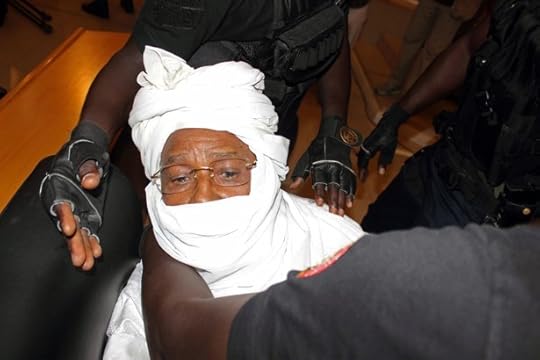
On the face of it, Augusto Pinochet and Hissène Habré have little in common—besides both being backed by the U.S. during the Cold War. Pinochet, the longtime Chilean president, saw himself as a conservative defender of traditional values and was a staunch opponent of communism. Habré, the former Chadian president, was a desert warlord who billed himself as an anti-imperialist who quoted Mao Zedong and Che Guevara.
But the arrest of Pinochet in London 18 years ago Friday set an important precedent that resulted in Habré’s ongoing trial in Senegal on charges of crimes against humanity, says Reed Brody, counsel and spokesman for Human Rights Watch who is one of the driving forces behind the trial.
“This case is a direct result of the Pinochet case,” he said in a telephone interview from Dakar, the Senegalese capital. “When the House of Lords ruled that Pinochet could be arrested and prosecuted anywhere in the world, despite his status as a former head of state, the human-rights movement was in effervescence. It showed that we had an instrument to hold accountable people who seemed out of the reach of justice until then.”
Pinochet came to power in 1973 in a coup in which he toppled Salvador Allende, the head of the country’s left-wing government. Over the next nearly two decades, he left behind a legacy of torture, executions, and disappearances. He left office in 1990, but maintained powerful positions in the military and the senate. But Pinochet never stood trial—partly because of his age and health—and died in 2006 while under house arrest in Chile.
Still, soon after the House of Lords stripped Pinochet of his immunity in 1998, Brody says he was approached about trying to do the same thing with Habré.
“We kind of gave him the monicker the African Pinochet as a way of underlining what it was that we were trying to do: brining a dictator to justice in the country where he was found and applying the Pinochet principle in Africa,” Brody said.
Habré, who came to power in 1982, is accused of killing and torturing thousands of people during his eight years as Chad’s president. He was ousted in 1990 and has lived in Senegal since then. But in 2013, after much stalling, Senegal indicted Habré, and that’s where he is being tried in a court backed by the African Union.
It’s the culmination of two decades of campaigning by Habré’s accusers and human-rights groups to bring him to justice. As we reported in July, it’s the first African demonstration of the principle of universal jurisdiction, which allows national courts to prosecute crimes committed abroad.
This week, Habré’s trial ended its seventh week. Witnesses in the case so far include human-rights activists, Chadian officials, a Belgian judge who had studied the case, and Bandjim Bandoum, a former head of Habré’s political police, the Documentation and Security Directorate (DDS).
“Records of the questioning of detainees came back from the presidency with annotations: E for ‘execute’; L for ‘set free’ or V for ‘seen,’” Bandoum said in testimony last month, which was reported by AFP. He said Habré was “aware of everything that was happening” in the department's detention centers.
But Mbaye Sene, who is defending Habré, questioned the extent of the role Habré had in the DDS’s actions.
“If you’ve never been to the presidency, you’ve never talked to him, tell me how Hissène Habré gave you orders,” he said.
He asked prosecution witness Mahamat Hassan Abakar, who heads a commission investigating atrocities committed under Habré: “You say that the DDS was the president’s ‘thing’—then prove it.”
It’s an attempt to introduce doubt into the case against Habré. Brody points out that one challenge in the case is to show Habré bears legal responsibility for the crimes—not just to prove the crime.
“A lot of the challenge for the prosecution and for the victims ... is to show that Habré either directly or indirectly bears legal responsibility,” he said.
Another challenge has to do with the legitimacy of the court itself. Habré, 72, has called the court “illegitimate and illegal,” and both he and his lawyers had refused to participate. Habré had to be dragged into court and was prone to outbursts while he was there. The court adjourned for 45 days in July to give his court-appointed lawyers time to prepare for the trial.
Habré is now brought in before the daily proceedings begin. He sits silently through the day with his face wrapped in a turban and his eyes covered by sunglasses. Mere feet away from him, witness after witness recounts being tortured or losing loved ones. But there are challenges with the testimony, too.
“There are a number of witnesses who have been very forceful. And a number of witnesses who didn’t remember very much,” Brody said. “In many cases, you’re dealing with illiterate people about things that happened 30 years ago.”
Usually, a trial such as this would go to the International Criminal Court, which was set up to handle circumstances such as these. But the ICC has a checkered reputation on the continent. As my colleague David Graham has reported:
Opinion about the ICC has shifted in Africa since it was chartered in 1998. Initially, it had strong support—particularly in the aftermath of the Rwanda genocide, [Brookings Institution scholar John Mukum] Mbaku has written, when “there was an urgent need in Africa to squarely confront impunity and the mass violation of human rights.” Since then, some governments and thinkers have apparently revised their opinions.
One reason is that every indictment issued by the ICC has been in Africa. The court’s jurisdiction is somewhat hobbled by the non-participation or non-cooperation of many countries, most notably the United States. But the fact remains that Africa has been the focus of a court based in Europe, and given that memories of colonialism are in some places still fresh and very raw, that raises hackles.
Add to that the fact that while the court can mete out an abstract sort of justice, it has little power to make things right for victims. It’s all well and good to lock up a perpetrator, but it doesn’t do much to restore the damage. When those trials happen in The Hague, far away from where the crimes were committed, there may be little chance for many victims to take part in the proceedings anyway.
Habré’s trial—which is being live-streamed on the Internet, and being closely watched in Chad—might point towards a model of how such cases can be tried in Africa, rather than in The Hague. As Brody said in an in interview in July:
“What is remarkable about this case is that the victims, the survivors have been the architects, the driving force behind this case, and people see that. In this case, the optics here, the way the case has been played out very publicly, particularly in French Africa ... people have been following the saga of the victims.”









Zombies and Taylor Swift: The Week in Pop-Culture Writing

All You Zombies
Elmo Keep | The Awl
“These fictional visions of End Times—zombies, an irradiated techno-dystopia, encroaching frozen wastes—are all spaces in which to achieve catharsis by safely exploring the anxieties of a post-social world without having to meaningfully engage with any of our current behaviors which are contributing to bringing it about in the real world—our rapidly dwindling resources and rising seas. Instead we are placated.”
Ermahgerddon: The Untold Story of the Ermahgerd Girl
Darryn King | Vanity Fair
“Another factor of the picture’s appeal, even ignoring the caption, is its nostalgic resonance. Ermahgerd was a cognitive flashback for Millennials—the most active demographic on the Internet—and their recollection of the ’90s. It was the same time-capsule effect that, in 2005, contributed to the virality of a YouTube video of two siblings unwrapping a Nintendo 64 on Christmas Day—a home video that, Goldenberger thinks, was probably recorded within 12 months of the Ermahgerd picture being taken.”
Taylor Swift on “Bad Blood,” Kanye West, and How People Interpret Her Lyrics
Chuck Klosterman | GQ
“There’s simply no antecedent for this kind of career: a cross-genre, youth-oriented, critically acclaimed colossus based entirely on the intuitive songwriting merits of a single female artist. It’s as if mid-period Garth Brooks was also early Liz Phair, minus the hat and the swearing. As a phenomenon, it’s absolutely new.”
Sunday Night Football Is the Best Show on TV
Jody Rosen | Slate
“Our pro-TV zealotry is curiously narrowly cast. The television commentariat focuses almost exclusively on dramas, hip comedies, and those warhorses that date back to TV’s first golden age, late-night talk/variety shows. This leaves out much of television’s bread and butter: news, most reality TV, game shows, daytime soaps and syndicated chat shows, children’s programs. And sports.”
The Making of John Wayne
Anne Helen Petersen | Buzzfeed
“The image of John Wayne on offer at the museum is a tapestry of half-truths and tall tales, a myth meant to assuage a nation’s anxieties and assure its citizens that a certain type of man, with a sort of principle, was still central to American identity.”
A-List Directors, Interviewed by Sam Mendes
Sam Mendes | Empire
“WHY DIDN’T YOU JUST BECOME AN ACCOUNTANT?
Spielberg: I could never have been an accountant. I got a D in math.
Fincher: I’m not good enough with ‘people’ to do that kind of work.
Joe Wright: If I could have done anything other than become a director I probably would have, but I couldn’t see any other options. It was all I could do and all I ever wanted to do.”
Game Met Match: Pick-up Artist Godhead Neil Strauss’s Subtle, Surprising New Book
Lux Alptraum | Grantland
“It is easy to see The Truth as the comfortable tale of a prodigal son who abandons monogamy for hedonism, only to return to the comforts of a two-person relationship. It’s easy to gloss over the lines here and there that expressly dismantle that interpretation.”
Superheroes: Born in New York City
Michael Powell | The New York Times
“My friends and I roamed the city in search of dusty shops with piles of old comics filled with such mysteries. We found a favorite haunt on Amsterdam Avenue, an unnamed, often-padlocked storefront known as ‘the old lady’s place.’ To get there we had to walk by the teenage boys at Joan of Arc Middle School, who shook us down for quarters. Where was Batman when you needed him?”
The Knick Is Just as Concerned With the Policing of Bodies as It Is With Fixing Them
Moze Halperin | Flavorwire
“More and more, The Knick’s depiction of the 1900s seems to survey the coalescence of systems of American oppression that still persist, a map of a power structure that spells out collective misery—even for the privileged. What it shows, with brutal repetition, is the havoc these systems wreak on the human body.”
The Last Love Song by Tracy Daugherty Review: Joan Didion’s Resurgence
Laura Miller | The Guardian
“She is as remote as the moon, too, because Daugherty was unable to secure her cooperation in researching his book. No matter, Didion has written copiously about herself, and Daugherty also believes that she is a mirror of sorts for American society in the 20th century (and a little beyond).”









The Not-Quite End of the Book Tour
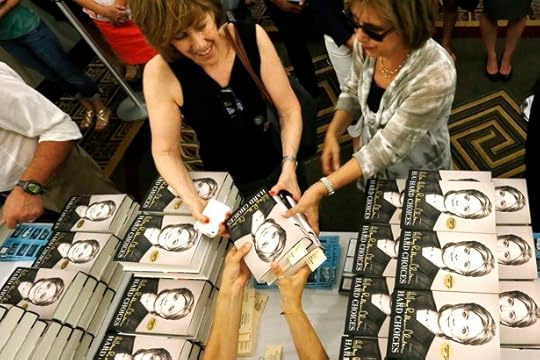
As I was flying from my home in Slovenia to New York for a week-long tour to promote my new book in June, I fantasized about the knishes and bialys I would consume during my travels. Even while daydreaming, though, I was acutely aware of what a rarity it is these days for an author to be sent on a book tour at all. In recent years, and especially since the recession of 2008, when author advances shrunk and publishing had to tighten its collective belt, one of the first things to go were book tours (not to mention the all-but-extinct beast called the “book release party.”)
For publishers, sending authors on tour is expensive—they have to cover transport, meals, and nice hotels. And perhaps more importantly, touring doesn’t necessarily translate into better book sales. It’s hard to tell, in fact, what effect they have at all, as sales records don’t show what prompted someone to buy the book, only where the book was purchased. With the publication of my two books, most recently The Art of Forgery in June, I’ve found myself part of a lucky group that still gets to partake in this somewhat fading institution. I’ve witnessed firsthand how publishers have adapted to a changing industry—by becoming more selective about which authors to send on tour, which promotional appearances to secure, and how to make the dollars stretch.
The editors and publicists I spoke to for this article explained that, back in the day, publishers would send authors out on tour fairly regularly—the more events and cities covered, the better. But in this new, more austere era, publishers only regularly pay to send authors who are compelling public speakers, authors with large established audiences who are guaranteed to sell well and therefore cover expenses (the James Pattersons, Gary Shteyngarts, J.K. Rowlings, and so on), or authors with a high profile that extends beyond books (such as actors, athletes, comedians). Publishers might send the odd debut writer, in hopes of more media coverage, but it’s no longer a given.
Obviously not falling into the second or third category, I’m more the kind of author who gets a kick out of the times I’ve been able to go out, meet people, and talk about my books. For me, writing is a great but solitary activity, normally undertaken in a dark room, alone, while I’m in my pajamas. I enjoy the adrenaline of performance; the bigger the audience, the better. I’ve spoken for audiences ranging in size from 700 to three (more on that later), and been interviewed by everyone from local blogs with a readership in the low hundreds to the BBC. But I’m aware that being offered these opportunities is a huge privilege, and not the norm—for most authors the publicity process involves phone or email interviews, with maybe a single local bookstore event.
In order to swing sending authors out on tour, publishers today have to make compromises. Previously, authors would get a company credit card and sort out their own travel arrangements, accommodations, and meals without supervision—often a wasteful approach. Then publishers began to experiment with sending publicists out with authors to serve two functions: as a fixer (with a theoretically more measured use of the company credit card) and chaperone. But this meant double the expense: twice the plane and train tickets, twice the meals, twice the hotels. Then arrived another solution that I only learned about on my first tour, back in 2007 for my novel The Art Thief. It peeled back the veil over this quasi-legendary concept of authors on tour (I imagined groupies, whiskey, cigarette smoke, typewriters), and exposed me to a new, and completely fascinating, role that I never knew existed: that of the awkwardly named “escort.”
Author escorts are local residents of the cities visited by those of us on tour, and are subcontracted by publishers to meet and guide authors who come into town. (You can spot them at airports and train stations, because they’re always carrying a copy of your book.) Most in my experience have been elegant, middle-aged women with pearl necklaces and SUVs and husbands in banking, women who read vast numbers of books, know their cities inside out, and are thrilled to show visitors around. They do have the company credit card, and anything you do while they’re with you is paid for (free food is the siren song for writers, impossible to resist). In all, the escort system is a more cost-effective way to get authors where they need to be: Because escorts live in the city in question, the publisher doesn’t need to fly them in or spring for their hotel.
Escorts, for their part, make hectic book tours exponentially easier. On my first tour in 2007, I ping-ponged around 12 cities, and not in any order that made geographic sense (for some reason San Francisco was scheduled for the day between events in Austin and Houston). I’d get up each morning around 6, groggily pack up my bag at another hotel, and be driven to the airport for an early flight to the next city. There I’d be picked up by the next escort, who’d be smiling and brandishing my book. My escort would bring me to interviews, radio stations, TV studios, press junkets in hotel rooms, to meals (they always know the best places to eat), and then to the book event.
Blurry-eyed authors, uncertain of the day of the week, their current location, or just who is president of the United States, require handholding to maintain such a packed schedule. My most recent tour for The Art of Forgery, which ended in June, included five cities in seven days, with three of the cities featuring in a single day: up at 5 a.m. in Boston, a flight to New York to film an interview for CBS This Morning, then a train to New Haven for an event.
Escorts are often the most interesting person an author will meet on a book tour. In Chicago for The Art Thief, my escort was an aspiring writer planning to pen a memoir called Super Jew, while my San Francisco escort was a novelist who had a hit about Beat vampires back in the ’70s. Authors can go a bit stir crazy, repeating roughly the same presentation night after night, and answering the same questions interview after interview, so a bit of spontaneity and company can be refreshing.
By and large, book tours mostly entail maneuvering to get on radio shows or TV programs, and less glamorous elements, like attending bookstore readings where hardly anyone shows up. At one reading, I had only three people in the audience—including my escort for that city ... and my dad. At the time, I didn’t understand why my publisher had flown me all the way out to play, essentially, to an empty house. But then the store manager wheeled out hundreds of books to sign for the first-edition mail club, and I understood: Book events are not just about selling to the people who attend them, which even for prominent authors can mean only a few dozen copies sold. They’re about getting authors local media attention, getting bookstore staffers face time with authors so they can promote the books, and signing copies. While signed books do sell better, they also can’t be returned to the publisher if they don’t sell—a win-win for publishers.
The national end of things can be even trickier to navigate. From my publisher’s perspective, the main selling point on my U.S. tour in June was my appearance on Fresh Air, a nationally syndicated NPR radio show that’s considered the ne plus ultra of book-selling radio. The host Terry Gross is mistress of 4.5 million regular listeners who consume books like Tic Tacs and who are the target audience for all American publishers of non-fiction, and anything literary.
In a world this big, it’s a wonderful thing that encounters like these help keep people’s love of books alive.So many interviews these days are by phone or Skype or email that it’s not strictly necessary to have Author A in Location B in order to get media coverage, but Fresh Air is an exception, preferring guests who can appear in the flesh. And while I did major live events in Washington, D.C. and in New York, each event only reached a few hundred people, at most. My NPR appearance alone justified the considerable cost of paying my way to, and around the U.S. on this tour, because it was bound to offer a boost in sales. While touring alone may be expensive and rarely leads directly to better book sales, Fresh Air alone can launch a bestseller.
Programs like Fresh Air can take on an outsize influence given the tenuous state of book reviewing—the practice has been purportedly dying since at least 1959. On the TV end of things, this year marked the departure of two major promotional platforms for the book industry: The Daily Show With Jon Stewart and The Colbert Report, where renowned public intellectuals and authors from small presses alike could get national attention. As Alex Shephard of the independent publisher Melville House noted, “an appearance [on those shows] couldn’t guarantee a book would become a bestseller, but it was about as close to a sure thing as you could get in an incredibly uncertain marketplace.” He added that the loss of The Daily Show and The Colbert Report should serve as a reminder that the book industry has long relied on third parties such as critics for promotion and that it should think of new, better ways to market itself. It’s unclear whether publishers will see tours as part of the future of book-selling—but for the sake of readers and writers alike, they should.
With the exception of the recent movie about David Foster Wallace, The End of the Tour, there are few recent examples of book tours in popular culture, making the institution a hazy myth in most people’s minds. Which means few are aware of the unfortunate changes that have befallen the tradition. Book tours for the already-famous will always continue, but there’s a real danger that publishers will decide that the rest of us authors are no longer worth sending on tour at all, a trend that is well under way. This would be a great shame: Tours are often the only chance for writers to spend time with the actual people who read their books. There’s already a big disconnect between readers and authors, who often exist only as an abstraction, as a name on a book spine, or perhaps as a Facebook “friend” you’ve never seen in the flesh.
Tours bridge that gap. The TV appearances may be the shiniest of the trophies on publicists’ walls, but there’s no feeling as good for an author as shaking the hand of someone who genuinely loved something you wrote. And as a reader, I can say that I get a jolt of endorphins when I meet a favorite author in person; it’s a surreal event that all but guarantees I’ll remain a devoted reader for years to come. In a world this big, it’s a wonderful thing that encounters like these help keep people’s love of books alive. So it’s my sincere hope that the publishing industry won’t let the book tour die, not just as a writer, but as a reader. As flawed, fatiguing, and unreliable as it is, it is also undeniably special.









October 16, 2015
Hungarian Walls
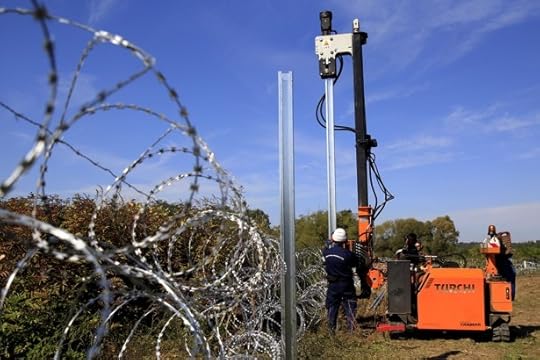
Hungary will close its border with Croatia at midnight in an attempt to prevent migrants from entering the country, officials said Friday.
Hungarian Foreign Minister Peter Szijjarto said people would only be able to cross into the country through official border stations and submit asylum requests at two locations. Reuters reported. The country completed construction of a razor-wire barrier along the 220-mile border with Croatia this week.
More than 378,000 migrants and refugees bound for Europe have crossed into Hungary since the start of the year, fleeing war and poverty in their native countries, mostly in the Middle East. The vast majority of them are making their way westward to Germany, which has suspended the European Union’s usual rules for asylum-seekers specifically for Syrians fleeing that country’s civil war.
Hungary sealed its 110-mile border with Serbia with a similar fence last month, leaving thousands of migrants stranded. They went through Croatia instead, where the government transported them on buses and trains to Hungary’s border with Austria. With the Croatia border sealed, migrants will be forced to look for alternate routes, perhaps through Romania, which has so far not been a major transit country for them.
Hungary’s fence is a sobering symbol of the fractured and arduous European effort to handle the worst refugee crisis since World War II. On the opposite side of the spectrum, Germany, the preferred final destination of the majority of refugees, is operating under an open-door policy. Croatia, Serbia, and Romania, along with Western European nations, have criticized Hungary’s border policy. The European Union agreed last month on mandatory quotas to relocate 120,000 migrants across the continent. Hungary, Romania, Slovakia, and the Czech Republic voted against the plan, but they were overruled. Britain has been granted an exception to the quotas, but has promised to resettle 4,000 refugees this year and 20,000 over the next five—all from Syria.
This week, Hungarian Prime Minister Viktor Orban said he wants Greece—the biggest point of entry into Central Europe for refugees—to close off its borders, too. On Friday, EU leaders announced that Turkey had agreed to do more to stem the entry of migrants to Europe in exchange for looser visa restrictions and renewed talks about Turkey’s application to the bloc. But Turkey denied that a deal had been finalized.
There is some evidence Hungary’s border policy has worsened the crisis. Here’s what happened when refugees learned in August that Hungary was going to seal off its border with Serbia, from The New York Times:
Paradoxically, far from deterring the migrants, Hungary’s fence may actually be spurring them on. In a dozen or so fractured interviews this weekend, many Syrians, Afghans and others said that word of the fence had accelerated their race to get north before all of the Hungarian border with Serbia — almost 109 miles — is cordoned off, a goal that the Hungarians have set for Aug. 31.
Robert Lesmajster, a veteran of refugee aid organizations who greeted people in Serbia, told the Times: “They all want to go to Germany. Their ‘promised land.’… The Hungarian fence cannot stop them.”









How Stephen Colbert Is Bringing Religion to Late Night

Stephen Colbert is a practicing Christian. He is an ordained minister. He teaches Sunday school. He is a person of deep faith and, more generally, of deep spirituality. That fact doesn’t come up very often in his work—certainly not when he was playing an arrogant blowhard on The Colbert Report, and not a lot, understandably, in his new role as the host of The Late Show. Late-night comedy and religion—late-night comedy and spirituality—have not traditionally been bedfellows.
Religion came up last night, though.
Related Story
The Stealthy Humanism of Stephen Colbert
The context was this: Oprah was guesting on The Late Show to promote Belief, a seven-night miniseries on her cable network, OWN, that will explore the origins and impacts of different religious—and not quite religious—faiths. Oprah, reverting easily to her days as a talk-show host, was charming and chatty. She joked about how, when she was younger (“I’m talking 7, 8, 9, 12, 15”), she’d been “a little preacher.” Her fellow students used to say, she recalled, “Here comes that preacher girl again.” And their comments seemed warranted. “I was preaching the Gospel, yes, I was,” Oprah said. “I remembered the Bible verses and passages.”
Which was occasion for Colbert to ask her which of those Bible verses and passages is her favorite.
Oprah, perhaps knowing his background, asked him what his favorite verse was.
“Mine’s from Matthew,” Colbert replied. “I like it because Jesus says, ‘So I say to you, do not worry, for who among you by worrying could change a hair on his head, or add a cubit to the span of his life?’”
He added: “What I like about it is that it’s a commandment to not worry, and I’ll go with that.”
Then it was Oprah’s turn. “Mine is Psalms 37:4,” she said. “‘Delight thyself’—I love that word ‘delight,’ don’t you? I’m so glad that David knew it,” she said (referring to King David, the author of the Psalms).
She continued, quoting the full verse, “Delight thyself in the Lord. He will give you the desires of your heart.”
She added:
Now what that says to me is “Lord” has a wide range. What is “Lord”? Compassion, love, forgiveness, kindness. So you delight yourself in those virtues where the character of the Lord is revealed. Delight thyself in goodness, delight thyself in love, kindness, and compassion, and you will receive the desires of your heart. It says to me, if you focus on being a force for good, good things will come.
Which … is not the typical stuff of late night. Colbert has gone of out his way to infuse his show with a kind of moral sensibility; on Thursday, however, his normally holistic humanism took a specifically religious (and specifically Christian) bent. It wasn’t the first time, to be sure, that Colbert has discussed his religion publicly. It wasn’t even the first time that Colbert has discussed his religion on his show. During his faith-infused interview with Joe Biden—a fellow Catholic—Colbert asked his guest, “How did you maintain your real soul in a city that is so filled with people who are trying to lie to us in subtle ways?”
This time around, with the “little preacher” as his guest, Colbert used Belief’s blunt title to ask Oprah whether she thinks there’s a distinction between “belief” and “faith.”
“Yeah, there is,” she replied. “Because there are a lot of people who don’t think they’re faithful people, but have beliefs. You cannot be in the world without believing in something, even if you don’t call it a deity. So there are people who believe in working hard and striving for their best, but don’t necessarily have a religious belief.”
Colbert seems to be ignoring Frank Rich’s declaration that “his key to late-night success is avoiding piety.”Faith, on the other hand, she continued, “is very different, I think.” Faith “is knowing that no matter what, you’re going to be okay. And I’ve always been a part of that faithful.”
So, by all accounts, has Colbert. And now, significantly, the host seems to be actively ignoring Frank Rich’s declaration, made after the premiere of The Late Show With Stephen Colbert, that “his key to late-night success is avoiding piety.” Piety was there, Thursday night, in abundance. And, perhaps even more significantly, without apology.
Which did not stop the two late-night Christians from appreciating the context of their quasi-theological discussion. When Oprah shared her favorite Bible verse with him, Colbert responded not just with a nod of recognition, but with a perfectly juvenile quip. “Oh, David was into delighting himself,” he said.
To which the two dissolved into giggles.









Crimson Peak: A Gothic Romance to Die For
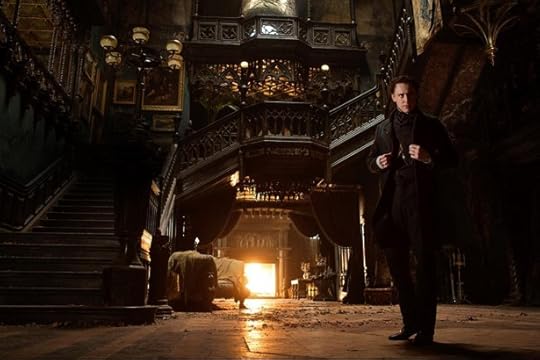
During a tense, pivotal moment in Guillermo del Toro’s new thriller, Crimson Peak, Lady Lucille Sharpe (Jessica Chastain) serves a young bride, Edith Cushing, (Mia Wasikowska) a cup of tea. Every moment is infused with as much drama as possible; as Lucille spoons sugar into the tea, she scrapes it along the rim, towards Edith, with what can only be described as murderous intent. That’s the kind of movie Crimson Peak is: Del Toro won’t let a scene pass without smashing the audience in the face with it, but you can’t help but admire his audacity.
Related Story
The Enduring Creepiness of Haunted-House Films
The director has shied away from describing Crimson Peak as a horror film, though it contains many ghosts, a few jump scares, and as many suspenseful creaks and groans as can fit in its two-hour running time. Instead, he’s billed it as a “Gothic romance” in the vein of Alfred Hitchcock’s Rebecca or George Cukor’s Gaslight. In terms of dialogue and acting, the film certainly has that 1940s Old Hollywood style: The dialogue is either nakedly emotional or thuddingly symbolic, and the eventual plot twists are easy to get. Though Crimson Peak’s tone is arch enough that it won’t be for everyone, there’s definitely a gory, beating heart at its core.
The characters are straight out of a romance novel. Edith is the plucky heroine, an aspiring novelist patronized at every turn by 19th-century misogyny; her only defender is her industrialist father (Jim Beaver), who meets a nasty and suspicious end when he objects to her new suitor, the penniless English lord Thomas Sharpe (Tom Hiddleston). Thomas whisks Edith off to his family home, a crumbling manse nicknamed Crimson Peak that is, without hyperbole, the most-haunted house in the history of the world.
It has a good half-dozen ghosts, rendered in sinewy CGI with much dripping blood and exposed muscle, creeping and shrieking around at night for Edith to fret over. It’s built over a scarlet clay mine, so it looks like blood is literally seeping from the walls and floorboards. There’s a creepy basement filled with locked suitcases, a shuddering elevator, a secret attic, and Thomas’s brooding sister, Lucille, whose idea of hospitality is bursting into the room with a tea tray any time Edith gets too close to her newlywed husband.
The house’s many secrets are easy to lay bare, and Edith quickly sets about revealing them. Edith is being gaslit, certainly, as Thomas and Lucille try to convince her that she’s going mad, and simply imagining all the ghosts who clank around night after night. But in a twist on the Gothic formula, she’s got the fortitude to see past their assurances and stick up for herself. She also has a nice-guy suitor from back home in Buffalo, a doctor named Alan McMichael (Charlie Hunnam), who shows up trying to rescue her and mostly does a terrible job of it. In an older movie, Alan would be the strapping hero; here, he’s a bit of a doof, though a well-meaning one.
Thomas and Lucille, for all the secrets they’re carrying, are also more tragic antiheroes than full-on villains, although Chastain plays Lucille’s jealous intensity to the hilt. Her accent is wobbly, but her death stare is not; she’s matched in ferocity by the costume and production design, from the house itself (built in its entirety by the art director Thomas E. Sanders and stuffed with detail) to the many, many gowns. Del Toro, who’s made some great gore-fests in the past, also includes some shocking violence just to keep nerves extra frayed.
Crimson Peak will not be for everyone. It’s a gratuitous film, and proudly so, from the performances on down: If your reaction to a haunted house with non-stop bleeding walls is “that sounds like a bit much,” then everything else may end up feeling similarly on the nose. But its swooning emotion is consistent if nothing else, and builds to a marvelous crescendo with the final showdown, both in terms of thrills and pathos. To say more would be to spoil, but Del Toro certainly knows not to let any of his characters bid adieu without an on-the-nose monologue and extreme jab of violence. Now that’s a talent to die for.









A Drone Shot Down in Turkey
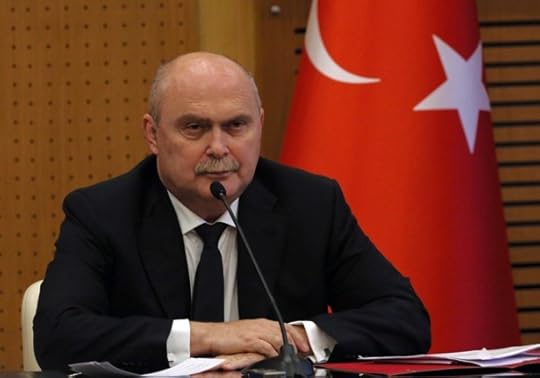
Turkish warplanes have shot down a drone belonging to an unidentified nation in Turkey’s airspace after issuing three warnings to it, the country’s military said.
“The aircraft, whose nationality could not be established, was downed by patrolling Turkish jets in accordance with engagement rules after it failed to heed three warnings,” the Turkish General Staff said in a statement on its website.
At a press conference later Friday, Foreign Minister Feridun Sinirlioglu identified the aircraft as a drone.
Reuters, quoting an unidentified U.S. military official, reported the drone was Russian. But Russian media quoted the country’s Defense Ministry as saying all Russian military planes returned to base in Syria after combat missions. Drones, the news reports said, were operating as planned.
Russia officially staged a military intervention in Syria’s civil war last month on behalf of President Bashar al-Assad. Since then, it has also launched missiles from the Caspian Sea against targets inside Syria. Russia says its target is the Islamic State, but many other groups that are fighting Assad, including those backed by the West, have also been hit. Russia’s intervention has raised tensions with the U.S. and its allies, who are conducting their own airstrikes in Syria against the Islamic State.
Russian warplanes have previously violated Turkish airspace, and Jens Stoltenberg, the NATO secretary-general, said those violation don’t “look like an accident.”









Atlantic Monthly Contributors's Blog
- Atlantic Monthly Contributors's profile
- 1 follower



